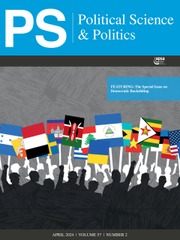No CrossRef data available.
Article contents
A Call to APSA Part 2: Bring in Community College Faculty
Published online by Cambridge University Press: 01 October 2021
Abstract
This article uses data from a 2018 survey conducted by the American Political Science Association Committee on the Status of Community Colleges in the Profession to make specific policy recommendations for how to better reach out to and incorporate political science faculty teaching at community colleges into the association.
- Type
- Article
- Information
- Copyright
- © The Author(s), 2021. Published by Cambridge University Press on behalf of the American Political Science Association
References
REFERENCES
American Association of Community Colleges. 2020. “Fast Facts 2020.” www.aacc.nche.edu/research-trends/fast-facts/aacc-2020-fact-sheet.Google Scholar
American Political Science Association. 2004. “APSA Task Force on Graduate Education.” Report to the APSA Council. Washington, DC.Google Scholar
American Political Science Association. 2020. “APSA Strategic Plan 2020–2022.” www.apsanet.org/Portals/54/goverance/APSA%20Strategic%20plan%202020-2022.pdf?ver=2020-06-11-124646-107.Google Scholar
Bayer, Alan E., and Braxton, John M.. 1998. “The Normative Structure of Community College Teaching: A Marker of Professionalism.” Journal of Higher Education 69 (2): 187–205.Google Scholar
Dolan, Julie, Kropf, Martha E., O’Connor, Karen, and Ezra, Marni. 1997. “The Future of Our Discipline: The Status of Doctoral Students in Political Science.” PS: Political Science & Politics 30 (4): 751–56.Google Scholar
Rothgeb, John M., Spadafore, Annemarie, and Burger, Betsy. 2007. “Faculty Training in Political Science: Results from a Survey of Department Chairs.” PS: Political Science & Politics 40 (4): 759–63.Google Scholar
Townsend, Barbara K., and LaPaglia, Nancy. 2000. “Are We Marginalized Within Academe? Perceptions of Two-Year College Faculty.” Community College Review 28 (1): 41–48.CrossRefGoogle Scholar
Weisman, Iris M., and Marr, John W. Jr. 2002. “Building Community: The Second Century, The Same Challenge.” New Directions for Community Colleges 2002 (118): 99–108.CrossRefGoogle Scholar


